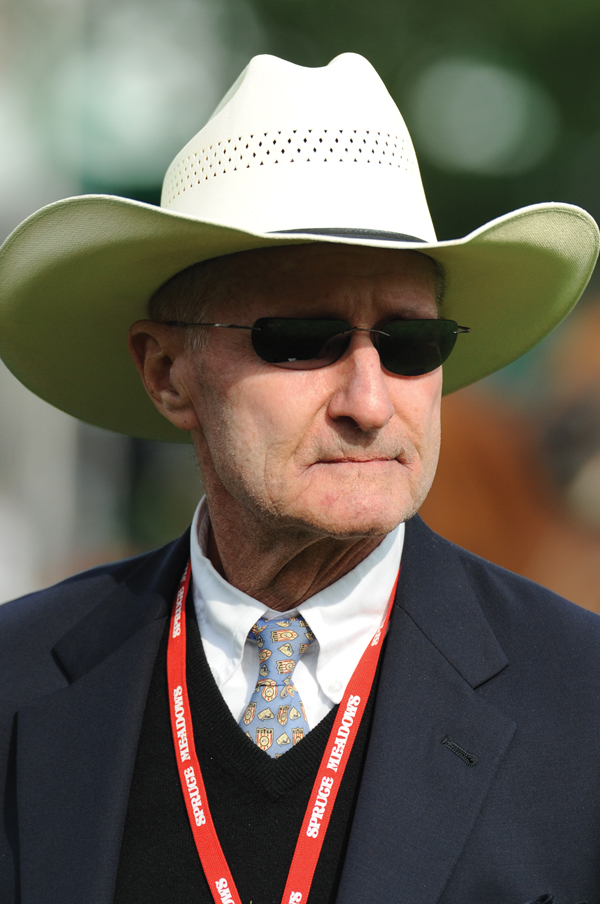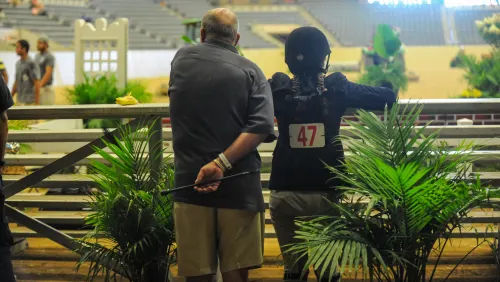The man was still as he sat in his golf cart. His body looked sinewy, but also old, like an elastic band that is drying up. His voice however, as it came over the loudspeakers, was strong. “Where did they go?” he asked.
The crowd looked around. The kids the man was enquiring about had been absorbed into the grandstands, but now they were being summoned back. They were teenagers acting as jump crew, and they had obviously, mistakenly, believed the session over.
“Where are they?” His voice was louder now, not angry, but accusatory and demanding. “I told them not to leave.”
A hush, as they say, fell over the crowd.
Everybody watched as the kids separated themselves from the crowd, urged forward by their parents, but not eager to be the center of attention. They pulled away from their families reluctantly and walked down the steps to the ring.
“Hurry!” The man’s voice bellowed over the loudspeakers and settled slowly over the stands, “Hurry!”
We all watched as one by one the kids broke into a run. As the first one got to the golf cart he slowed down and paused by the cart. It looked like he was talking to the man, but the other kids ran right on by, heading out to the jumps. And then, over the loudspeakers: “Don’t think. Don’t think!”
The boy who had stopped next to the golf cart turned red, a red I could see from 300 feet away.
“I’m here to think!” the man declared, looking out at the crowd now and seeing that he really had its attention now.
“In a few years you can think,” he finished, motioning the kid away with a small wave of his hand.
George Morris is known for saying exactly what’s on his mind.
The Water Jump
Next is the water jump, and George has the riders all in a light seat. “The modern way of riding,” he says. When a boy can’t quite get it right, he gets on.
“It’s simple,” he says as he canters down to the jump. “See.” His breathing comes clearly over the loudspeakers as he canters around to jump it again. “Simple,” heaving breathing, “simple. You can’t knock it down.” More breathing. And then as he approaches the jump he lets the reins loosen a little, but maintains his pace. “See?”
There are three components to a water jump: “pace, distance and tape.” A horse needs a good pace coming in; the rider needs to see a good distance and then ride past it, getting in close to the base; and finally jump the tape. Keep riding; like a runner hurling his chest forward, there should be no letting up until the finish line.
The next horse to try doesn’t quite clear it. There is a small splash as his hind legs dip into the water. George calls Mr. Madden down from the stands. “Come’ere Frank,” he says. “Give me a hand.”
They stand on either side of the water, about two thirds of the way down. Each one bent at the waist, arms straight. Each one holding one end of a blue and white rail. The horse canters down, the last few strides are longer and faster. The horse jumps, then stretches. He seems suspended for a second as the pole is lifted. As the horse hits it, the two men drop the pole.
ADVERTISEMENT
George looks out at the crowd: “Rapping…” I can’t wait to hear what he has to say. “…done carefully…” This can be a touchy topic. “…makes a safer jumper.”
And with that, the subject is over. The kids are dismissed, and the crowd disperses. “That was sort of anti-climactic,” a skinny girl a row ahead of me says to her friend. “Yeah,” her friend agrees.
Understanding Anne
In order to understand Anne Kursinski, in order to understand her style, it would help to have first seen George Morris.
George was Anne’s mentor at Hunterdon Farms for 17 years, and in many ways he still is. Whenever she competes for her country, he is the one coaching the team. He is the one on the ground, or in the golf cart, shouting directions, or offering advice.
Although Anne has developed her own style, she has stayed true to many of George’s philosophies. Like George, she is a perfectionist and a hard worker, and she expects the same out of everybody she works with. And like George, she is honest and outspoken, but nothing she says is personal, and she is quick to forgive and forget. She doesn’t like whining. And she doesn’t like excuses.
Foundation Is Key
The next day is equitation day. Flatwork with no stirrups. And it is raining, almost pelting, down. The crowd is only half as strong as the day before. And those who are there are huddled up in blankets or under umbrellas.
The kids ride in a large oval, using most of the ring. As they do walk-trot transitions, George warms up his voice. Jumping is “not dressage,” he declares. “It’s more like racing.”
And then, in one of the few times he’s had to correct himself: “Actually, it’s 50-50.”
George watches the transitions. “The great Masters of old called impulsion the mother of equitation.”
He wants to see more engagement, more hindquarters. A horse has to be worked on the back legs; everything comes from the hind legs. “A horse is built like a bridge,” he says. “Just like the Brooklyn Bridge, of which my great-great grandfather helped build.”
The point he is making is that the foundation is key. And the hindquarters are the foundation. “Most horses,” he says, “have back problems, and it’s not their fault. Most riders don’t know how to work a horse. They think they know how to work a horse.”
George’s clinics are almost non-stop talking. He lectures like a great professor: without notes and without repeating himself, sometimes flowing, sometimes flying, from one topic to the next. And all the time he eyes his students. He doesn’t miss a thing.
Not a thing. “Don’t ever let me see you saw your horses mouth!” he shouts, but the rain dampens the effect of his words, beating them into the ground. The crowd is subdued now, and a few people leave early. But I am happy to stay and watch, and I hope to see George ride again.
Great riders like Anne and George make the sport look easy. But they know, as well, or maybe more, than anyone else how much work goes into getting there. Anne has had George yell at her. And I’ve already had Anne yell at me. But if we are never taken out of our comfort zone, we’ll never learn.
After yelling, for the fourth time, (or maybe fifth) at the same kid, George admits, “I recognize these things cause I did ‘em. Those faults… I had ‘em.”
ADVERTISEMENT
There is nobody who is born a rider. It might come easier to some I think, either through money, coaching or raw talent, but nobody is born a rider.
George now has the kids practicing flying changes. The kids fly across the arena, some slowing, others speeding up as they try it.
“It’s disgraceful how horses make flying changes at these shows: bucking, tail swishing, pulling!” He pauses, his breathing can be heard, even above the rain. “That’s not permitted in my horse.”
Each horse tries one more change, which is better, and then George asks the riders to walk. Before they are even out of the trot George yells “It’s legs!” The kids are walking now, but George is still going strong: “It’s legs. Legs! Big sport is not about hands so much as legs.”
Finally he dismisses the riders, and the jump crew hand them coolers for their horses.
George looks out at the crowd. He has a few final thoughts to share, and he delivers them eloquently, like the patriarch of the sport that he is.
“It’s not about the social accessories, the money, the ribbons. It’s not about the winning; that comes easy.” He gets out of his golf cart and picks up his helmet from the back. “No, that comes easy.” He walks a step towards the crowd. “It’s about the horse; how to care for the horse, how to ride the horse, and how to look after this great animal – the horse.”
He stands there in the rain, which puddles and splashes around him. The crowd is anxious to leave, but I sit there for a minute. And in that minute I get to hear his actual final words. A lady has gone over to take his headset, and to thank him for his time. Her words come quietly out to me. I only catch a few words: “..were great… …always a good…”
And then George’s last words, as he fumbles with his headset, drift through the rain: “My typical obnoxious self you mean. Which I enjoy being. Difficult.” And he laughs a small laugh. “If I’m not being difficult, I’m not breathing.”
In that laugh and in those last words it’s possible that I just saw more of this man than most people ever do, of the awareness he has of his own powerful, fastidious and sometimes rude character. And then, beneath that I see an unpretentious, kind, visionary man. A private man. A man I would consider a Great Horseman.
And since I’ve seen George teach and heard him speak, then maybe I am a little closer to understanding Anne, the woman who has become one of his greatest students, and the woman I will spend the next three months learning from.
Back at Anne’s barn I pick up a broom. Here too, it is about the care, the thought that goes into their partnership. It’s about the details: When Anne travels she takes two boxes of spare bits, probably 200 bits in total. Like women and shoes, she has one for every occasion; some have been used once, and some may never get their chance. But they are there nevertheless. She has a box of spare tack that travels with her as well. It’s full of various nosebands, browbands, reins, cheekpieces and bitless bridles. (But not a single pair of draw reins.)
There are no shortcuts here, everything is in the details. I am on the board to ride two horses later today, but for now, for now, I continue sweeping the aisle.
In the summer of 2008 Tik Maynard came up with a grand plan. He decided to spend a year working for some of the greatest horsemen he could find in different disciplines and writing about his experiences. So far, he has worked for Johann Hinnemann, Ingrid Klimke, David and Karen O’Connor, Bruce Logan and Anne Kursinski. This article was written in January of 2010. For more information on Tik, visit www.tik.ca/.















